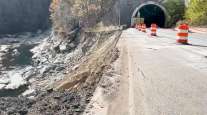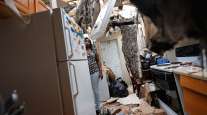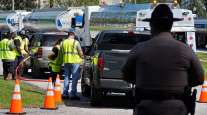Associated Press
Hurricane Ian Nears Florida Landfall

[Stay on top of transportation news: Get TTNews in your inbox.]
ST. PETERSBURG, Fla. — Hurricane Ian rapidly intensified as it neared landfall along Florida’s southwest coast Sept. 28, gaining top winds of 155 mph, just shy of the most dangerous Category 5 status. Damaging winds and rain lashed the state, and the heavily populated Naples to Sarasota region was at highest risk of a devastating storm surge.
U.S. Air Force hurricane hunters confirmed Ian gained strength over warm Gulf of Mexico water after battering Cuba, bringing down the country’s electricity grid and leaving the entire island without power. Ian’s center was about 25 miles west of Fort Myers at 2 p.m. EDT Sept. 28 as it churned toward toward the coast at 9 mph. Ian’s plodding pace meant the storm was expected to spend a day or more crawling across the Florida peninsula, dumping flooding rains of 12 to 18 inches across a broad area including Tampa, Orlando and Jacksonville in the state’s northeast corner.
“This is going to be a nasty nasty day, two days,” Florida Gov. Ron DeSantis said early Sept. 28, stressing that people in Ian’s path along the coast should rush to the safest possible shelter and stay there.

DeSantis
The massive storm appeared on track to slam ashore somewhere north of Fort Myers and some 125 miles (201 kilometers) south of Tampa, sparing the bay area from a rare direct hit from a hurricane. The area is popular with retirees and tourists drawn to pristine white sandy beaches and long barrier islands, which forecasters said could be completely inundated.
Catastrophic storm surges could push as much as 12 feet (3.6 meters) to 16 feet (4.9 meters) of water over coastal areas straddling Punta Gorda and Fort Myers, which are between Naples and Sarasota, the hurricane center warned. Rainfall near the area of landfall could top 18 inches (46 centimeters).

When tragedy strikes, heroes fight back. Transport Topics' Trucking's Frontline Heroes is back and looking for this year's trucking hero. Do you know someone who fearlessly faced tragedy in order to help others? Tell us about them here.
“If you are in any of those counties it is no longer possible to safely evacuate. It’s time to hunker down and prepare for the storm,” DeSantis said. “Do what you need to do to stay safe. If you are where that storm is approaching, you’re already in hazardous conditions. It’s going to get a lot worse very quickly. So please hunker down.”
More than 2.5 million people were under mandatory evacuation orders, but by law no one could be forced to flee. The governor said the state has 30,000 linemen, urban search and rescue teams and 7,000 National Guard troops from Florida and elsewhere ready to help once the weather clears.
“The assets we have are unprecedented in the state’s history and, unfortunately, they’ll need to be deployed,” DeSantis said.
Florida residents rushed ahead of the impact to board up their homes, stash precious belongings on upper floors and join long lines of cars leaving the shore.

Eastbound traffic crowds Interstate 4 as people evacuate in preparation for Hurricane Ian approaches the western side of the state. (Associated Press Photo/Phelan M. Ebenhack)
“You can’t do anything about natural disasters,” said Vinod Nair, who drove inland from the Tampa area Tuesday with his wife, son, dog and two kittens, seeking a hotel in Orlando, where only tropical-storm force winds were expected. “We live in a high risk zone, so we thought it best to evacuate.”
Winds exceeding tropical-storm strength of 39 mph (63 kph) reached Florida by 3 a.m. and the first hurricane-force winds were recorded by 6 a.m., well in advance of the eyewall moving inland, the Miami-based center said.
Overnight, Hurricane Ian went through a natural cycle when it lost its old eye and formed a new eye. The timing was bad for the Florida coast, because the storm got stronger and larger only hours before landfall. Ian went from 120 mph (193 kph) to 155 mph (250 kph) in just three hours, the second round of rapid intensification in the storm’s life cycle.
“With the higher intensity you’re going to see more extensive wind damage. The larger wind field means that more people will experience those storm-force winds,” University of Miami hurricane researcher Brian McNoldy said. And “it will really increase the amount of storm surge.”
.@FMCSA has issued a regional emergency declaration, granting emergency relief from 49 CFR § 395.3, maximum driving time for property-carrying vehicles for #HurricaneIan https://t.co/1fLbswU9qL — Florida Trucking Association (@FloridaTrucking) September 28, 2022
Ian’s forward movement shifted slightly southward, likely sparing Tampa and St. Petersburg their first direct hit by a major hurricane since 1921.
Instead, the most damaging winds could hit a rapidly developing coastline where the population has jumped sevenfold since 1970, according to the U.S. Census, which shows Lee County has seen the eighth largest population growth among more than 180 Atlantic and Gulf coast counties in the past 50 years.
There were 250,000 people in the Fort Myers/Lee County mandatory evacuation zones, and authorities worried ahead of the storm that only 10% or so would leave.
Gil Gonzalez wasn’t taking any chances. He boarded the windows of his Tampa home with plywood, laid down sandbags, and with his wife, packed their car with bottled water, flashlights, battery packs for their cellphones and a camp stove before evacuating. “All the prized possessions, we’ve put them upstairs in a friend’s house,” Gonzalez said.

Utility trucks are staged in The Villages of Sumter County, Fla. (Stephen M. Dowell/Orlando Sentinel via Associated Press)
Airports in Tampa, St. Petersburg and Key West closed, as did Disney World theme parks and Sea World in Orlando ahead of the storm.
A British couple vacationing in Tampa found themselves without beds. Glyn and Christine Williams of London were told to leave their hotel near the beach when evacuations were ordered. Because the airport shut down, they could get no flight home.
“Unfortunately, all the hotels are full or closed, so it looks as though we’re going to be in one of the shelters,” Christine Williams said.
Her husband insisted all would be fine. “You know, you got to go with the flow,” Glyn Williams said. “So we’re quite happy doing what we’re doing.”
The precise location of landfall was still uncertain, but with Ian’s tropical storm-force winds extending 175 miles (280 kilometers) from its center, flash floods were possible across the whole state. Parts of Florida’s east coast faced a storm surge threat as well, and isolated tornadoes were spinning off the storm well ahead of landfall. One tornado damaged small planes and a hangar at the North Perry Airport, west of Hollywood along the Atlantic coast.
Time is quickly running out for residents to rush preparations to completion on the southwestern Florida peninsula as Hurricane #Ian nears.
Tropical-Storm-Force winds already beginning to affect coast. Conditions will rapidly deteriorate & catastrophic wind damage is expected. pic.twitter.com/eHhEwPNLoY — National Hurricane Center (@NHC_Atlantic) September 28, 2022
Florida Power and Light warned those in Ian’s path to brace for days without electricity. As a precaution, hundreds of residents were being evacuated from several nursing homes in the Tampa area, where hospitals also were moving some patients.
Parts of Georgia and South Carolina also could see flooding rains and some coastal surge into Saturday. Georgia Gov. Brian Kemp preemptively declared an emergency, ordering 500 National Guard troops onto standby to respond as needed.
Before turning toward Florida, Ian struck Cuba’s Pinar del Rio province with sustained winds of 125 mph (205 kph) and causing destruction in the island nation’s world-famous tobacco belt. No deaths were reported.
Local government station TelePinar reported heavy damage at the main hospital in Pinar del Rio city, tweeting photos of collapsed ceilings, widely flung debris and toppled trees. Some people left the stricken area on foot, carrying their children, while buses tried to evacuated others through waterlogged streets. Others opted to stay at their damaged houses.
“It was horrible,” said Yusimi Palacios, a resident of Pinar del Rio inside her damaged house. “But here we are alive, and I only ask the Cuban revolution to help me with the roof and the mattress.”
Want more news? Listen to today's daily briefing below or go here for more info:




